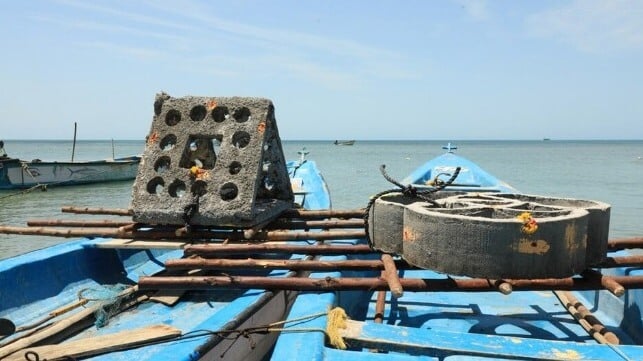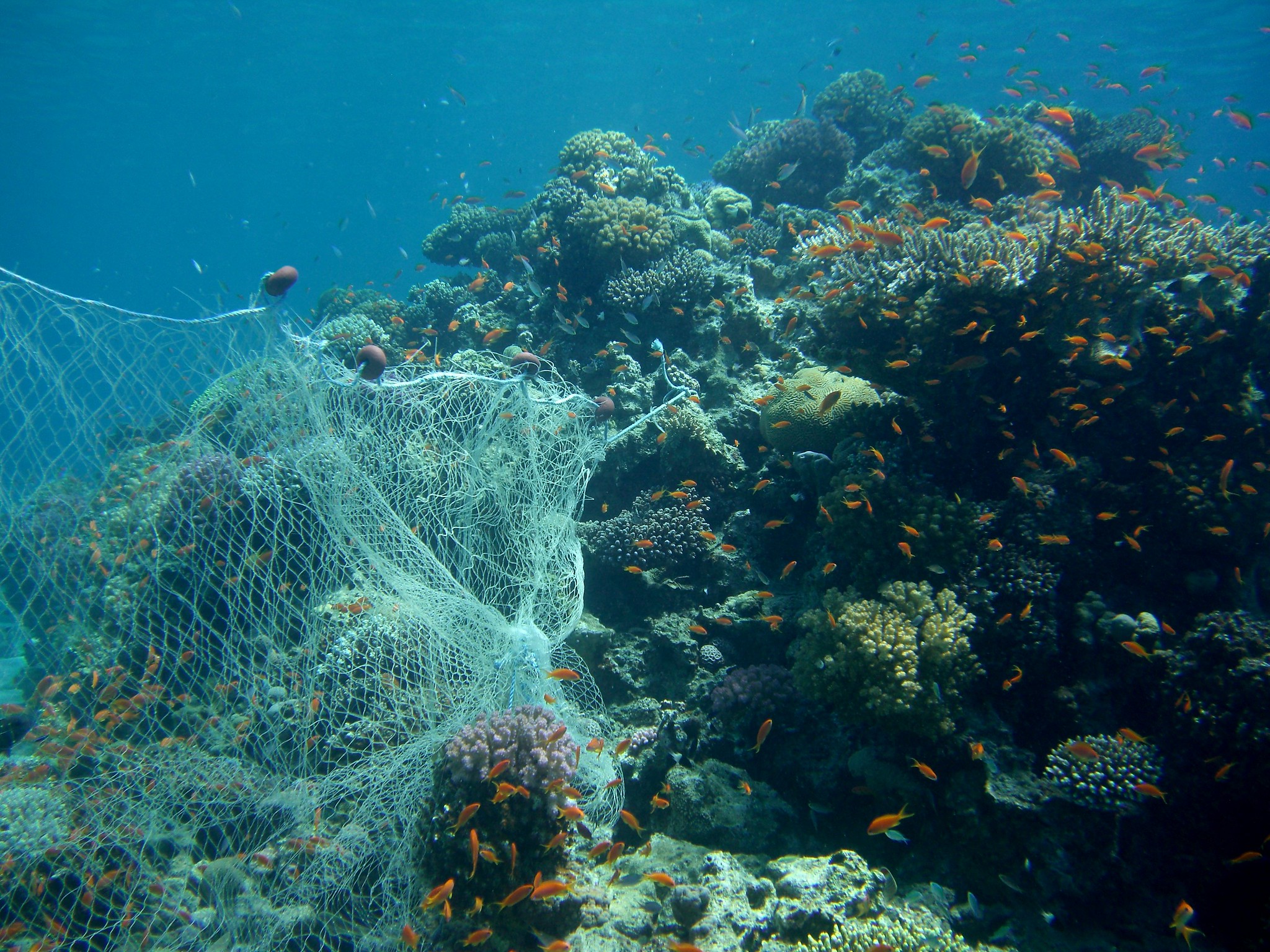India's Huge Artificial Reef Rollout May Cause More Harm Than Good
Thousands of planned artificial reefs may not increase fish populations, and could exacerbate coastal erosion

[By Haritha John]
Kasimedu is one of the largest and busiest fishing villages in Chennai, on the south-eastern coast of India. On one side of the port, large trawlers bring in substantial catches. On the other are moored small fiberglass boats belonging to fishers who rely on traditional methods, such as rod-and-line and occasionally nets.
Jayakumar, a leader in a local fishers’ association, highlights the challenges faced by traditional fishers: “It’s impossible for small fiber-boat fishermen to compete with large mechanized boats. When we used to go deep-sea fishing, the trawl boats would sweep up all the fish. Many traditional fishermen had to give up and work as laborers on trawl boats.”
To try and address this problem, 200 pieces of concrete were submerged at two coastal sites near Kasimedu in 2022 by the Participatory Learning Action Network and Training (Plant) group. The concrete was colonized by algae, shellfish and coral. Small fish and crustaceans shelter among them, attracting larger, predatory fish to these artificial reefs.
“After the reefs were installed, we no longer needed to go into the deep sea to find high-market-value fish, like kingfish and trevally,” says Arumugam, another local fisher. “I’m also able to save on fuel daily, as my boat doesn’t have to venture far for a good catch. There’s been a noticeable change in our income since the reefs were placed.”
Kasimedu is one of 25 fishing villages in Tamil Nadu where Plant has installed artificial reefs offshore. A conservation and social development organisation, Plant was founded by RT Suresh and is funded by the UN Development Programme, the Australian Embassy and The Energy and Resources Institute (Teri).
“The concrete reefs are placed on rocky, underwater areas, and within six months, biofilm, algae, plankton and other organisms begin to grow around them,” says Plant’s director, Amulrani. Many fishers in Kasimedu who benefit from these artificial reefs have requested more be installed. India’s central government appears to be listening. It announced a huge expansion of artificial reefs in 2023, which would bring them to thousands of the country’s fishing villages.
Artificial reefs are expensive to build and maintain. Fishing nets can get tangled in them. Some experts say they can just move rather than increase fish populations, and that they could cause coastal erosion.
From private to public
Dialogue Earth spoke to Robert Panipilla, an ocean researcher and the head of Friends of Marine Life. This Kerala-based organization works to enhance marine biodiversity. In the 1980s, it pioneered artificial reef projects in the state with fishers from the Vizhinjam coast, near India’s southern tip.
Panipilla says the earliest artificial reefs were ad hoc creations by local fishers: “Initially, someone would bring materials, drop them in a part of the sea, and declare that no one else could fish there. This was an attempt to privatise a section of the sea, but it sparked the idea of artificial reefs here… In 1990, we received funding from the Kerala government to deploy artificial reefs at Pozhiyoor, marking India’s first government-supported artificial reef project.”
Artificial reefs spread to different parts of India. In the 1990s, reefs of various materials were being installed west of Kerala, around the Lakshadweep Islands. The government’s Central Marine Fisheries Research Institute (CMFRI) held related workshops and trainings. By the 2010s, artificial reefs were being used in Tamil Nadu. In 2012, the CMFRI secured their patent for artificial reef structures made of concrete.
These reefs can serve multiple purposes: preventing trawling and erosion, fostering marine biodiversity, and encouraging surfing, diving and other recreation.
But the central government has taken on the project primarily to help fishing. In August 2023, the Department of Fisheries announced plans to install artificial reefs across 3,477 fishing villages nationwide, led by the CMFRI. According to official figures, the installation of 937 of these had been approved as of September 2024. These projects cover enough states and union territories to encompass most of India’s seaboard, at a total cost of INR 2.9 billion (USD 34.5 million).
The exact number of completed installations has not been released, but projects are progressing swiftly in multiple states. In Kerala’s capital, Thiruvananthapuram, the CMFRI began deploying artificial reefs across 42 fishing villages in 2023. In October, the state government submitted a proposal worth INR 550 million (USD 6.5 million) to expand the installation of artificial reefs to 192 fishing villages along Kerala’s coastline. There has also been work around Mumbai and Odisha.
“Marine ecosystems have suffered massive damage,” says Joe K Kizhakudan, head of the CMFRI. “Artificial reefs help restore small areas, addressing habitat loss, supporting fish species that can’t tolerate temperature changes and providing relief for fishermen facing intense competition. This project isn’t primarily for those economically well-off in the mechanised sector, but for traditional fishermen in need.”
Even before the central government’s push, artificial reefs were appearing in the wake of the devastating 2004 Indian Ocean earthquake and tsunami. According to the CMFRI, the damage accelerated a push by regional government and NGOs to install them across at least 200 sites in Tamil Nadu, in support of recovering fishers. This work is not cheap. According to Plant, producing and installing 200-300 artificial reef elements costs INR 2.5-3 million (USD 29,600-35,500). The CMFRI makes similar estimates, costing a reef of 250 modules at INR 3.5-4 million; Kizhakudan says the exact cost is dependent on the site, and factors such as labour and transport expenses.
The central government’s plan for thousands of new reefs is funded under the Prime Minister’s Fish Wealth Scheme (PMMSY). The central government funds 60% and the states provide the rest. But in Tamil Nadu, which became a focal point for artificial reefs in India following the 2004 tsunami, there are concerns about this rollout.
Concerns over artificial reefs
Along the coasts of Karaikal in Tamil Nadu, where fishers initially benefited from artificial reefs, reports of tangled nets and low catches have since thwarted them. “Not just one net – many nets get entangled in the artificial reef area, making it difficult for us to fish,” says local fisher Tamil Selva. “So, we don’t go there anymore.”
Some reefs are well-maintained, often by fishers, with entangled nets and other rubbish regularly removed. But fishers in Thoothukudi, Tamil Nadu, claim lots of artificial reefs in their area are no longer beneficial. “Many artificial reefs are neglected, and trawlers’ nets often get tangled in them. This has rendered certain areas useless for us,” says Selvan, a Thoothukudi fisher.
Panipilla criticizes agencies for placing artificial reefs in unnecessary locations. He says they are best suited to those places where fishers use hook-and-line methods, not nets: “In Thiruvananthapuram district, Kerala, there are 42 fishing villages, but only 50% have hook-and-line fishermen. Last year, CMFRI installed artificial reefs in all 42 villages, even in areas where they weren’t needed.
“Without follow-up cleaning, nets get trapped in these reefs and turn into ‘ghost fishing’ nets, which can remain at the sea bottom for hundreds of years, posing a long-term threat to marine life. How can this be considered a sustainable project?”
There has been little discussion or research into the potential biodiversity risks posed by poorly maintained artificial reefs, which is of concern for their advocates.
 Fishing nets can get tangled in natural and artificial reefs, and become ‘ghost fishing’ nets. Fishers in Thoothukudi, Tamil Nadu, claim that such structures stop being beneficial to them if neglected (Image: Tim Sheerman-Chase / Flickr, CC BY)
Fishing nets can get tangled in natural and artificial reefs, and become ‘ghost fishing’ nets. Fishers in Thoothukudi, Tamil Nadu, claim that such structures stop being beneficial to them if neglected (Image: Tim Sheerman-Chase / Flickr, CC BY)
“Artificial reefs should be deployed, but they must be properly maintained to serve their purpose,” says J K Patterson Edward, who directs Thoothukudi’s Suganthi Devadason Marine Research Institute. “A significant investment is made to support the ecosystem, yet in many areas, there is inadequate monitoring and maintenance.”
A government official associated with the Fisheries Department (who requested anonymity) says artificial reefs do not necessarily increase fish populations. Rather, they concentrate existing populations and make them easier to catch. “This can create an imbalance in the marine environment,” they say. “With hundreds of artificial reefs underwater, we’re essentially creating a managed fishing area, which could result in uneven fish distribution.” They also worry that these structures are potentially harboring invasive species.
Location, location, location
Where to site artificial reefs will be crucial as India creates more of them.
“Excessive [artificial reefs] close to shore may disrupt natural sand deposition cycles, leading to coastal erosion or unbalanced deposition,” warns Jagdish Bakan, who directs the Gulf of Mannar Marine Biosphere Reserve.
Bakan wants thorough analyses conducted before reefs are deployed, as happened under his management around Vaan Island. He emphasizes how these structures should not disrupt existing seagrass beds and flags some cases in which they have apparently been placed at random. He says extra attention should be paid near shorelines, because reefs can alter coastal wave dynamics.
As India accelerates its reef rollout, whether or not these precautions will be taken is unclear.
Panipilla says the reefs have sometimes been “used as a political tool, to quiet fishermen’s protests over livelihood issues caused by government coastal projects”. But he also remains optimistic: “The project to expand artificial reefs along the coasts is a great initiative and will benefit traditional fishermen – if it’s implemented properly.”
Haritha John is a journalist at Bengaluru’s The News Minute and has been reporting on southern India’s environmental issues since 2013.
This article appears courtesy of Dialogue Earth and may be found in its original form here.
The opinions expressed herein are the author's and not necessarily those of The Maritime Executive.
